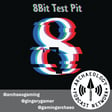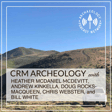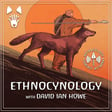Become a Creator today!Start creating today - Share your story with the world!
Start for free
00:00:00
00:00:01

Video Games as Archaeological Sites - Episode 5
On today's episode Andrew Reinhard talks about video games and archaeology. Can video games be archaeological sites?
Transcript
Introduction to the Podcast
00:00:01
Speaker
You are listening to the Archaeology Podcast Network. The Archaeology Podcast Network is sponsored by Codify, a California benefit corporation. Visit codify at www.codifi.com.
Viewing Video Games as Archaeological Sites
00:00:17
Speaker
Hi, this is Andrew Reinhard, and I wanted to spend the next 15 minutes or so today talking about how video games are actual archaeological sites, which might at first sound crazy. Maybe after 15 minutes it'll still sound crazy, but at least you'll understand the method to my madness.
00:00:40
Speaker
To start off, I think that a video game is a built environment which is something made by people for other people to use and in some case live in if the game is really really good. Video games also an archaeological site and today I wanted to explore the idea in more detail treating this less of an analogy and more as a way of applying archaeological methods and interpretation to digital interactive media and entertainment.
00:01:04
Speaker
In 2007, when I first began to think about games archeologically as a World of Warcraft player who happened to be an archeologist, I was distracted by the art and the architecture that Blizzard Entertainment's developers had put into the game. There were sites in the game, there was runes and ruins, ready-made material culture, ancient artifacts to find, and it wasn't until after I stopped playing WoW in 2012 that I began to perceive the game and all of its content and its community of players as being ripe for real archeological study.
Video Games as Artifacts
00:01:31
Speaker
I began to think about video games as being actual archaeological sites. It's perhaps clear to see how a video game can be an artifact. You need only think about 2014's excavation of the Atari burial ground, where we're actually picking the cartridges out of the earth.
00:01:48
Speaker
But understanding games as actual sites, you know, that's a little more complicated, I guess, in order to better understand how video games can be interpreted as archaeological sites, we need to first learn what defines a site in the real world. In the real world, an archaeological site is a place in which evidence of past activities preserved, which may be investigated using the methods of archaeology and represents part of the archaeological record, which is the body of physical evidence about the past.
00:02:13
Speaker
The archaeological record is formed over time and can change based on human or another agent's interaction with the material in the record. Archaeological sites are populated by material remains, which can be grouped together into datasets and then interpreted by the archaeologist.
00:02:27
Speaker
Now, this is true for ancient sites. It is for contemporary ones. You need to think back to Cornelius Holthorpe's more liberal interpretation of sites which acknowledges the meanings of archaeological sites and artifacts. These always change. They can't be fixed to a particular locus in time or space. Archaeological sites mean very different things to different people. And these meanings are equally important among all those
Entropy in Archaeological Records
00:02:52
Speaker
people.
00:02:52
Speaker
These meanings also include those emerging from the socio-cultural and political baggage within the archaeologist conducting the research, or of the many voices or multifocalities of the site's occupants past and present, which is something that Ian Hodder defines as reflexive methodology.
00:03:08
Speaker
When we deal with the digital, the conceptual approaches and concerns involved are the same as when we're dealing with real world sites. Everything tends towards a state of entropy, which is why the archaeological record is both incomplete and difficult to define. While natural mechanical processes constantly work to erase or change the archaeological past, similar processes occur within the digital media.
00:03:29
Speaker
which are by their nature, degenerative, forgetful, erasable. Digital media are stored or have storage, not unlike the Earth, which is really, if you think about it, planet-sized storage. Archaeological data are locked in structures and in assemblages, both underground and above ground, just as digital data are stored.
00:03:46
Speaker
In both cases, data are gradually lost. Methods of storage are, as they are, they're being imperfect. But there's also memory, which is an intangible archaeology, something to be interpreted when the real or virtual site is explored. There's no difference, at least in my mind, between the archaeology of the digital and the non-digital.
Games as Discrete Archaeological Entities
00:04:05
Speaker
The concepts of formation processes of the archaeological record and the methodological approaches to them are the same. Sites like artifacts have a history of use that continues from their origin into the present day. Sites are never not used, although they may exist in stasis until they're rediscovered.
00:04:23
Speaker
The above definition is about what makes up an archaeological site, which is part of the archaeological record and is affected by formation processes. This all applies to video games and I propose the following points in an attempt to further define and defend video games as archaeological sites.
00:04:37
Speaker
Number one, a video game is a discrete entity where the place can be defined as the space in which the game is installed, which is not necessarily its installation media. The past activity is the coding that created the game and its elements can be directly observed and manipulated part of the record of the game.
00:04:56
Speaker
Video game installation media, for example, a tape, a cartridge, or a disc, is not only an artifact, but is also an archaeological site. Just as with real world sites, installation of media is bounded within the confines of the physical space containing smaller entities that comprise the media, adding a level of cohesiveness to all of the digital parts that make up the overarching game.
00:05:17
Speaker
These directories, files, structures, hierarchies, or all themselves discrete entities, but combined to create a unified whole, just as the site is defined by its boundaries and the sum of its parts. The game media were created by one or more people for others to inhabit and creating a culture around those players who choose to inhabit the game space. For example, the community of players in the original MUD in 1978. The game media became part of the archeological record upon production,
00:05:45
Speaker
and it leaves behind evidence in the form of material remains as well as a documented history of occupation by both developers and players. Number three, the game is played as played which is accessed via installed digital media is also an archaeological site. The game as played is its own world
00:06:05
Speaker
in which one or more players interact and which contains its own digital artifacts, either created via errors in code or created as artificial constructs to be perceived by players as actual representations of real-world things that can be manipulated in game space. Past activity includes, at the extra game level, updates, patches, bug fixes, mods, expansions, and in the in-game level,
00:06:25
Speaker
Past activity includes the actions of one or more avatars and their effects on the game space, whether it be moving in-game items from one place to the next, or the destruction and construction of something semi-permanent in the virtual world. Archaeologists can explore the game sites on the surface, analyzing the game media. They can do it from within, via file systems and structures, and through play by interacting with the game space as created by the developers.
00:06:51
Speaker
The games preserve evidence of past activity, from production to use to disposal, from installation to use to deletion, from beginning to gameplay to the final boss. And the amount and nature of preserved evidence varies from game to game, as it does with real-world sites.
Documenting Virtual Worlds
00:07:05
Speaker
Sometimes what remains is data-rich, and other times ones left with only a trace of fleeting occupation.
00:07:13
Speaker
With Virtual Worlds, there are a number of ways to document the locations of archaeological sites on both levels, the in-game and the extra-game. In-game, some games actually contain their own location systems, for example, Tomb Raider Definitive Edition, where players can record XY coordinates on a Cartesian grid. With games featuring maps, depending on the hardware used to play the game, you can take a screen grab and then apply a regular grid over the top of it.
00:07:36
Speaker
as a layer using imaging software and other map-less games. They still allow for the assignment of in-game locations via text tool descriptors, for example level name and a description of the player's surroundings. It lacks pinpoint exactness, reading more like an explorer's journal entry, but the usefulness of the qualitative notes become less clear when dealing with games comprised of vast regions to explore. But I figure if Heinrich Schliemann can find the ancient city of Troy by way of reading the Iliad, then perhaps there's hope that an intrepid player
00:08:05
Speaker
could do the same based on an observation, reading literature provided in-game and online, and accompanied by a little luck. Considering the loci of physical sites in the games themselves, this could be an IP address of a game server, server farm, local client hardware. These boxes or arrays occupy a physical space and could be considered as meta sites, the plastic and metal wrappers containing the game site.
00:08:31
Speaker
Games might also be located by knowing the whereabouts of the development computers or possibly the master media onto which the game's design was saved. With these game sites comes a stratigraphy of build numbers and versions, sometimes stacking on top of each other, other times replacing the code that came before, not unlike the layers of the ancient city of Troy or the use of Spolia to create new monuments and cities from the old.
00:08:54
Speaker
The game artifact, as it existed in the past, it still does, but to a lesser extent with direct downloads taking over the market now. This was created at least by one person, but with the help of machines, resulting in distributed things, sometimes with market value, that contains within its production a history of creation, a possible inscription, and has a fine spot, or more than one fine spot as its biography grows.
00:09:17
Speaker
The artifact of the game provides the heart, sometimes still beating, of the game space as well as the metadata. Its developer created information, a mobile inscription, a container of text and image. The cartridge or disc is a vessel with the wine, the stone upon which the writing was carved containing the deeper meaning born of words and syntax.
00:09:36
Speaker
It's the physical manifestation of code wrapped in layers of instructions that created the portable package, a world in itself containing a world within. Of those games that exist independently of physical media, accessible only through the hardware connected to a network or to the internet, these are digital artifacts lacking in materiality that behave in the same way as their physical counterparts.
Boundaries of Digital Archaeological Sites
00:09:56
Speaker
For example, the copy of Uncharted 4 that I downloaded plays exactly the same as the copy purchased at a brick and mortar retailer.
00:10:03
Speaker
The final question to consider, though, is when can we call what we're looking at a site? In the real world, the archaeologist can determine the boundaries of a site through investigation of the physical material remains, whether a fixed border of a wall, for example, or the petering out of a distribution of flakes left behind from tool production.
00:10:22
Speaker
The archaeological record gradually transitions from sight to other, like the layers of the atmosphere transitioning from the Earth into space, and as archaeological sites are composed of the remains of human occupation, the archaeologist must consider those things left behind to create a provisional history of the site, or at the very least a definition of the site itself.
00:10:45
Speaker
Now in dealing with digital media, archaeologists such as Gabe Machinska or Sarah Perry and Colleen Morgan have explored USB sticks and hard drives as archaeological sites. Now these containers hold a file structure composed of directories, subdirectories and files.
00:11:00
Speaker
that when taken separately are themselves artifacts but taken together they compose an archaeological site. Games are no different. For older PC games one could browse to the installation directory and gradually tease out the files and contents of those files that when used together generated the game space on screen.
00:11:16
Speaker
As installation media have grown in sophistication, those files and their contents have become obfuscated, but all of the elements used to create the game for the player remain. These games are sites composed of artifacts working together and electrified society of automatons. In traditional archaeology, one cannot pick up a site and move it.
00:11:35
Speaker
at least I don't think you can. For the game archaeologists, all sites are portable, as are the artifacts that they contain.
Interactive Environments of Games
00:11:41
Speaker
Both have multiple moving parts that all contribute to the meaning of the site they comprise. The artifacts from your network are created by culture. In the case of the video games history, creation originates from pop culture, industry trends, the design spec. The game site is constructed, then reconstructed, and is always in a state of modification.
00:11:59
Speaker
the networked pieces that contribute to an emergence of a broader meaning and the creation of an interactive environment. As with any archaeological site, real or virtual, the site is a system, it's a network, that the archaeologist can attempt to break down into its constituent interacting agents from whose behaviors and interactions various systems level properties may emerge. This is the definition of agent-based modeling. Pieces of the whole work together to create an interactive environment, be it the city of Athens or a digital simulation of it.
Multiple Uses of Video Games
00:12:29
Speaker
an archaeological site communicates a lot of things, and it can be used in several different ways at once. Holtorf describes these as an appeals of archaeological sites as having, and this is a list from him, these sites have monumentality, which means big and visible is important.
00:12:45
Speaker
factual detail or conformity with educational values, commerce or commercial exploitation of sites, social order or reception that mirrors the present, identities, personal relation to the past, aesthetics or romance and scenery of ruins, reflection, aura, nostalgia, ideology, adventures, magical places, and progress.
00:13:04
Speaker
Now, if you take a game like Assassin's Creed Unity as a site, you'll find that all of the above uses apply equally to the virtual as they do to the real. In the case of open worlds, games that allow for free movement of play, video games behave even more like the real world counterparts.
00:13:20
Speaker
In EVE Online, there are no developer-ordained goals or traditional in-game, and instead, players band together to create their own goals, annex their own little corner of the universe, form alliances, foster animosities with other groups, and create its own in-game lore. There's no difference between the archaeological understanding of a real-world place and a video game. These sites are formed in the same way, grow and change through mechanical, natural, and human intervention, contain the same data,
00:13:45
Speaker
which lends itself to the same questions archaeologists have asked for over a century. Perhaps most simply put, video games are built environments, which can also be classed as archaeological sites.
Digital Spaces as Archaeological Sites
00:13:55
Speaker
Archaeologists understand built environments to be constructed by people for people, creating a manufactured space for everyday living, working, and recreation.
00:14:02
Speaker
For many people, including myself, that includes video games, digital built environments, especially in the case of MMOs and open worlds. I give these digital spaces hundreds, sometimes thousands of hours of my time, spend my real world money to inhabit environments, and build my own social networks within them.
00:14:20
Speaker
Some people even make real-world living through their endgame interactions, such as professional community managers or professional esports players. These games, these video games, have become the sites for a new archaeology and one that simultaneously embraces the real with the virtual.
Conclusion and Credits
00:14:37
Speaker
Thanks.
00:14:48
Speaker
If you like what you've heard, subscribe and share us with your social network. 8-Bit Test Pit is available on iTunes, Stitcher and Google Play or online at the Archaeology Podcast Network site. Be sure to comment and give us a like wherever you listen and consider donating to the show and the network on our website, archaeologypodcastnetwork.com. 8-Bit Test Pit is produced by Sarah Head and Tristan Boyle. Music is provided by Tristan Boyle. Thanks for listening.
00:15:19
Speaker
The show is produced by Chris Webster and Tristan Boyle and edited by Chris Sims. This has been a presentation of the Archaeology Podcast Network. Visit us on the web for show notes and other podcasts at www.archaeologypodcastnetwork.com Contact us at chrisatarchaeologypodcastnetwork.com








